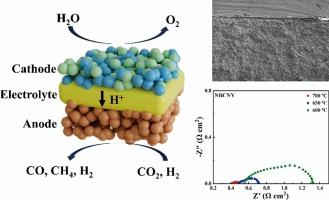NdBaCo1.8Nb0.1Y0.1O5+δ作为质子陶瓷电解电池高效耐用的空气电极
IF 4.6
3区 材料科学
Q2 MATERIALS SCIENCE, MULTIDISCIPLINARY
引用次数: 0
摘要
质子陶瓷电解电池因其高能量转换效率而受到广泛关注。空气电极对氧还原反应(ORR)和析氧反应(OER)具有较高的催化活性,是解决反应动力学缓慢的关键。本文设计了一种新型的钙钛矿空气电极材料ndba1 - xco1.8 nb0.1 y0.1 +δ (NBCNY)。作为空气电极,NdBa1-xCo1.8Nb0.1-xY0.1-xO5+δ与BaZr0.1Ce0.7Y0.1Yb0.1O3-δ (BZCYYb)电解质具有良好的化学相容性。由于氧空位浓度高,NBCNY在700℃时的面积比电阻(ASR)极低,仅为0.077 Ω cm2。在700℃和1.5 V条件下,采用NBCNY空气电极的PCEC电池在H2O和CO2/H2O共电解模式下的电流密度分别为2.51 a cm−2和2.64 a cm−2。此外,具有NBCNY空气电极的pcec具有超过100小时的耐久性。本文章由计算机程序翻译,如有差异,请以英文原文为准。

NdBaCo1.8Nb0.1Y0.1O5+δ as an efficient and durable air electrode for protonic ceramic electrolysis cells
Proton ceramic electrolysis cells (PCECs) have received a lot of attention due to their high energy conversion efficiency. Air electrode with high catalytic activities toward oxygen reduction reaction (ORR) and the oxygen evolution reaction (OER) are critical due to the sluggish reaction kinetics. In this work, a novel perovskite air electrode material of NdBaCo1.8Nb0.1Y0.1O5+δ (NBCNY) was designed by co-doping Nb and Y. As an air electrode, the NdBa1-xCo1.8Nb0.1-xY0.1-xO5+δ exhibits superior chemical compatibility with BaZr0.1Ce0.7Y0.1Yb0.1O3-δ (BZCYYb) electrolyte. The high oxygen vacancy concentration of NBCNY leads to an extremely low areal specific resistance (ASR) of 0.077 Ω cm2 at 700 °C. At 700 °C and 1.5 V, the PCEC cell with NBCNY air electrode achieves a current density of 2.51 A cm−2 and 2.64 A cm−2 in H2O and CO2/H2O co-electrolysis modes, respectively. Furthermore, PCECs with NBCNY air electrode shows exceptional durability for more than 100 h.
求助全文
通过发布文献求助,成功后即可免费获取论文全文。
去求助
来源期刊

Materials Science and Engineering: B
工程技术-材料科学:综合
CiteScore
5.60
自引率
2.80%
发文量
481
审稿时长
3.5 months
期刊介绍:
The journal provides an international medium for the publication of theoretical and experimental studies and reviews related to the electronic, electrochemical, ionic, magnetic, optical, and biosensing properties of solid state materials in bulk, thin film and particulate forms. Papers dealing with synthesis, processing, characterization, structure, physical properties and computational aspects of nano-crystalline, crystalline, amorphous and glassy forms of ceramics, semiconductors, layered insertion compounds, low-dimensional compounds and systems, fast-ion conductors, polymers and dielectrics are viewed as suitable for publication. Articles focused on nano-structured aspects of these advanced solid-state materials will also be considered suitable.
 求助内容:
求助内容: 应助结果提醒方式:
应助结果提醒方式:


